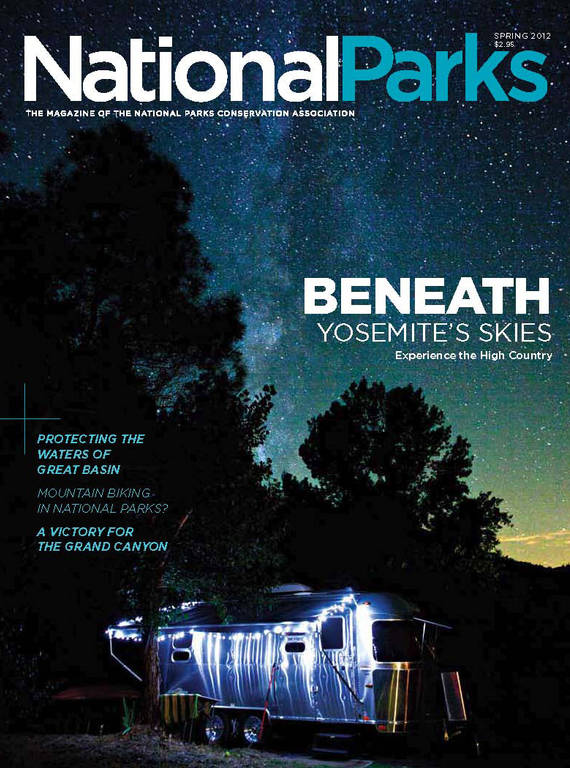Spring 2012
Friends in High Places
EcoFlight offers an aerial view of the national parks, and the threats looming within and beyond their boundaries.
For nearly thirty years, Bruce Gordon has been squeezing as many people as he can fit into his tiny Cessna and flying them over the American West. His mission: To give his passengers a better understanding of the large-scale environmental issues that plague our landscapes, from beetle outbreaks, to road construction, to oil and gas development—issues that can be nearly impossible to grasp from the ground.
In 2002, Gordon put an official name on those excursions when he founded EcoFlight, a nonprofit organization that’s proven especially valuable for the preservation of our national parks. He’s flown passengers over the California Desert to illustrate the risks posed by massive solar developments, and the importance of the proposed California Desert Protection Act, which would create two new park units.
Gordon has flown clients over the Greater Yellowstone Area, where climate change is favoring beetle outbreaks, and entire mountains of whitebark pine are dying as a result. The view from the air was so alarming that it spurred the U.S. Forest Service to pursue the first-ever baseline climate change study using the dying trees as their subjects. (The same study helped put the Yellowstone grizzly bear, which feast on whitebark pine seeds, back on the endangered species list).
EcoFlight has also hosted tours over the Four Corners, where oil and gas development threaten the region’s parks; Glacier, Montana, where glaciers are melting at shocking rates; Rocky Mountain, Colorado, where pine beetles are killing trees by the masses; and the Grand Tetons in Wyoming, where flights helped the Park Service envision a bike trail to cut down on traffic.
“These issues exist in vast areas that can be really hard to access on the ground,” Gordon says. “You really get the big picture up in the air.”
EcoFlight passengers are as diverse as the parks themselves—conservationists, reporters, politicians, tribal members, faith-based leaders, Young Republicans, ranchers, hunters. “We try to put diverse members of the community on each flight,” Gordon says, “and by that I mean people who are not traditional conservationists or even aligned with the environmental movement. That’s how we make sure we’re not just preaching to the choir.”

National Parks
You can read this and other stories about history, nature, culture, art, conservation, travel, science and more in National Parks magazine. Your tax-deductible membership donation of $25 or more entitles…
See more ›Because here’s the thing: Something magical happens when you squeeze people into a tiny space and take them 10,000 feet up in the air. “It’s very intimate,” says Jane Pargiter, EcoFlight’s vice president. “Everyone is close together—they’re touching elbows, touching knees. And you might have people with very different opinions sitting next to each other, but because they’re all a little nervous and a little excited, and they’re in this space together, it’s a great place to find out what else they have in common.”
The transformations can be amazing. Gordon recalls loggers who were horrified at the vast amount of forest they had cut down, and conservative ranchers who paid little mind to oil and gas development until they saw it from the air, creeping perilously close to their land. Pargiter recalls private land owners in Colorado who opposed a nearby wilderness designation, until they saw the proposed area from the air and realized it would actually protect their property. Once they hit the ground, passengers like these have gone on to become some of the most outspoken environmental advocates.
“I think the American public and the politicians take the natural parks for granted,” Pargiter says. “It’s something they grew up with—they figure the parks are there, and they’re going to be there forever. I don’t think enough people understand how special these places are, and that they might not be here tomorrow if they’re not taken care of today.”
Fledgling Environmentalists
In the 1980s, EcoFlight’s Jane Pargiter taught at the college level in South Africa, a place where students were actively engaged in politics and social issues. So when she moved to the United States 23 years ago, she was shocked to learn that young Americans could be so apathetic. “Many of the teenagers I met were born with a golden spoon in their mouths,” she says. “Everything was handed to them on a platter, and they just weren’t interested in voting or being active in pursuing change.”
That’s when Pargiter vowed to grow the student-focused program at EcoFlight, where she could engage high school and college students in local environmental issues. The Kestrel Program runs a few times a year and brings together hundreds of students from the region’s schools, where they can take part in live, round-table discussions led by guest speakers from both sides of the aisle; afterwards, pilot Bruce Gordon takes a handful of these students up in the air. EcoFlight also features a Flight Across America Student Program, where students from Colorado universities fly over a threatened ecosystem. Last year, four students toured the Four Corners, where they witnessed an aerial view of sprawling oil and gas development outside the national parks. Watch a short video of their expedition:
About the author
-
 Amy Leinbach Marquis
Amy Leinbach MarquisAmy Leinbach Marquis is former associate editor at National Parks magazine.



